Anaerobic Digestion: Startup, Co-Digestion, and Operational Parameters
VerifiedAdded on 2023/06/13
|7
|1369
|211
Homework Assignment
AI Summary
This assignment delves into the intricacies of anaerobic digestion, focusing on the start-up phase, co-digestion strategies, and the critical operational parameters that influence biogas production. It highlights the differences between the start-up and normal operation of a digester, emphasizing the importance of monitoring feed rate, temperature, biogas production, and pH levels during the initial phase. The assignment also explores co-digestion techniques, utilizing substrates with high C/N ratios like food waste and garden waste to enhance methane production, while also addressing the optimal substrate/co-substrate ratios, considering factors like buffer capacity and volatile fatty acid volume. Furthermore, it identifies essential parameters such as pH, temperature, alkalinity, volatile fatty acids, molecular hydrogen, total volatile solids, methane content, and total ammonia-nitrogen that need to be monitored and controlled to prevent digester failure and maintain optimal performance. This assignment provides a comprehensive overview of the key elements involved in successful anaerobic digestion and biogas production.
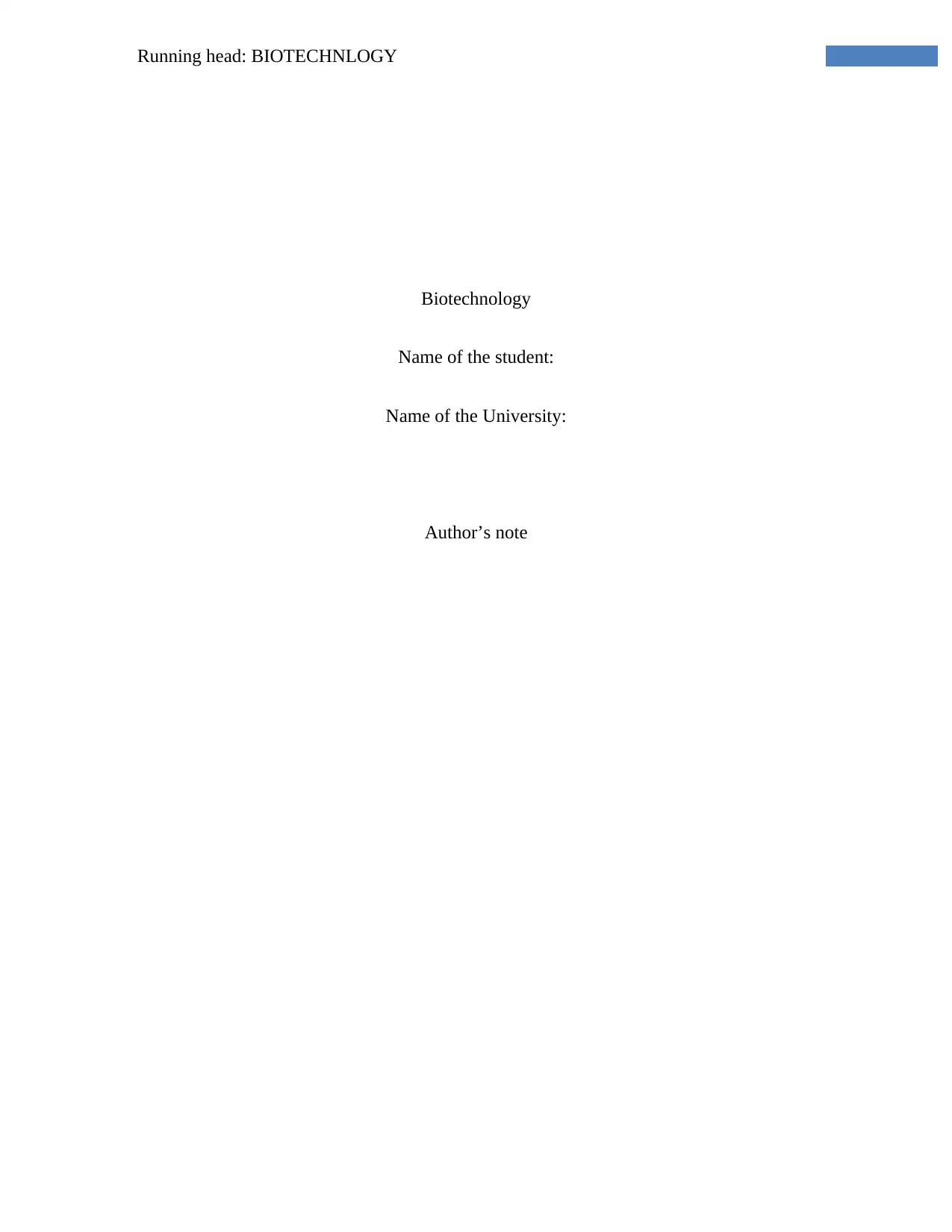
Running head: BIOTECHNLOGY
Biotechnology
Name of the student:
Name of the University:
Author’s note
Biotechnology
Name of the student:
Name of the University:
Author’s note
Paraphrase This Document
Need a fresh take? Get an instant paraphrase of this document with our AI Paraphraser
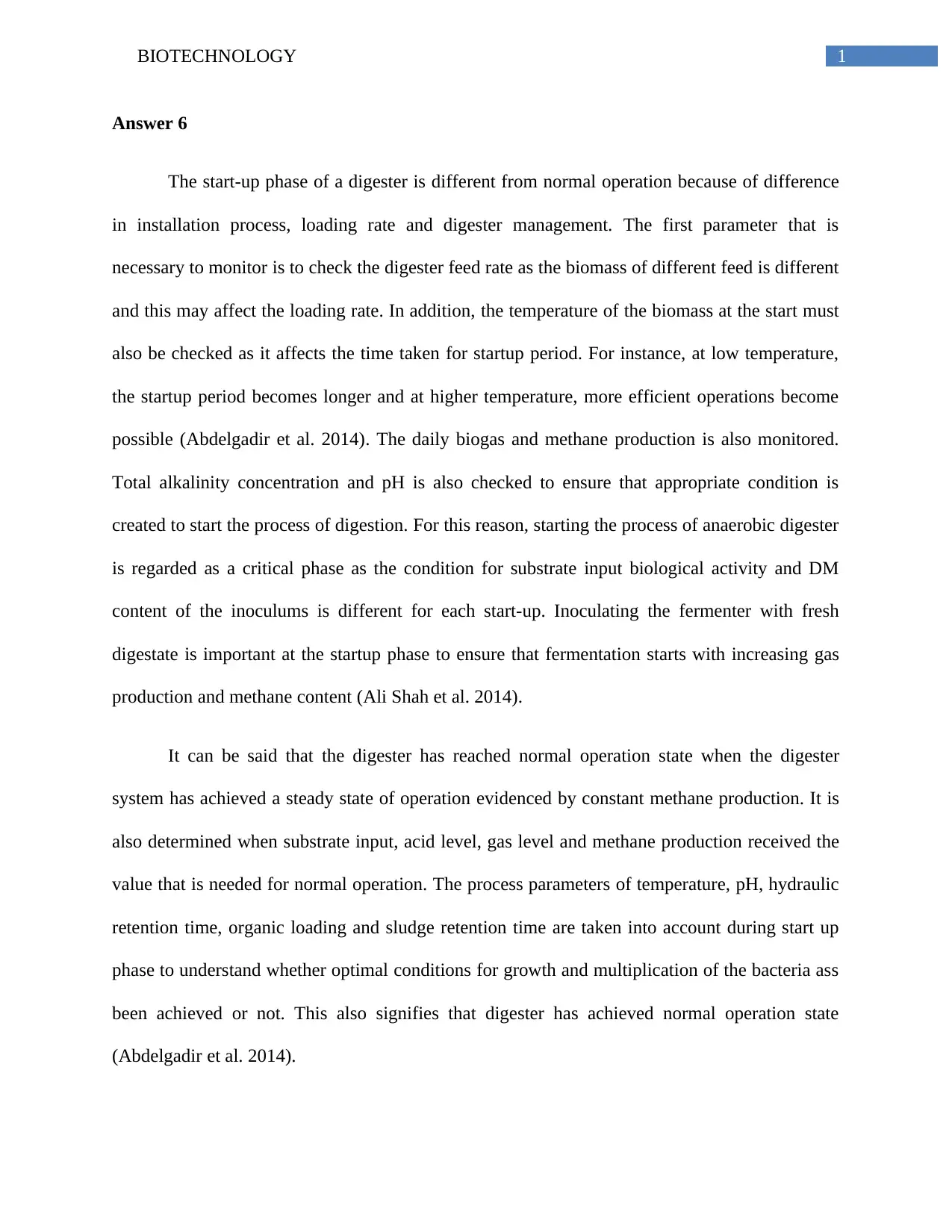
1BIOTECHNOLOGY
Answer 6
The start-up phase of a digester is different from normal operation because of difference
in installation process, loading rate and digester management. The first parameter that is
necessary to monitor is to check the digester feed rate as the biomass of different feed is different
and this may affect the loading rate. In addition, the temperature of the biomass at the start must
also be checked as it affects the time taken for startup period. For instance, at low temperature,
the startup period becomes longer and at higher temperature, more efficient operations become
possible (Abdelgadir et al. 2014). The daily biogas and methane production is also monitored.
Total alkalinity concentration and pH is also checked to ensure that appropriate condition is
created to start the process of digestion. For this reason, starting the process of anaerobic digester
is regarded as a critical phase as the condition for substrate input biological activity and DM
content of the inoculums is different for each start-up. Inoculating the fermenter with fresh
digestate is important at the startup phase to ensure that fermentation starts with increasing gas
production and methane content (Ali Shah et al. 2014).
It can be said that the digester has reached normal operation state when the digester
system has achieved a steady state of operation evidenced by constant methane production. It is
also determined when substrate input, acid level, gas level and methane production received the
value that is needed for normal operation. The process parameters of temperature, pH, hydraulic
retention time, organic loading and sludge retention time are taken into account during start up
phase to understand whether optimal conditions for growth and multiplication of the bacteria ass
been achieved or not. This also signifies that digester has achieved normal operation state
(Abdelgadir et al. 2014).
Answer 6
The start-up phase of a digester is different from normal operation because of difference
in installation process, loading rate and digester management. The first parameter that is
necessary to monitor is to check the digester feed rate as the biomass of different feed is different
and this may affect the loading rate. In addition, the temperature of the biomass at the start must
also be checked as it affects the time taken for startup period. For instance, at low temperature,
the startup period becomes longer and at higher temperature, more efficient operations become
possible (Abdelgadir et al. 2014). The daily biogas and methane production is also monitored.
Total alkalinity concentration and pH is also checked to ensure that appropriate condition is
created to start the process of digestion. For this reason, starting the process of anaerobic digester
is regarded as a critical phase as the condition for substrate input biological activity and DM
content of the inoculums is different for each start-up. Inoculating the fermenter with fresh
digestate is important at the startup phase to ensure that fermentation starts with increasing gas
production and methane content (Ali Shah et al. 2014).
It can be said that the digester has reached normal operation state when the digester
system has achieved a steady state of operation evidenced by constant methane production. It is
also determined when substrate input, acid level, gas level and methane production received the
value that is needed for normal operation. The process parameters of temperature, pH, hydraulic
retention time, organic loading and sludge retention time are taken into account during start up
phase to understand whether optimal conditions for growth and multiplication of the bacteria ass
been achieved or not. This also signifies that digester has achieved normal operation state
(Abdelgadir et al. 2014).
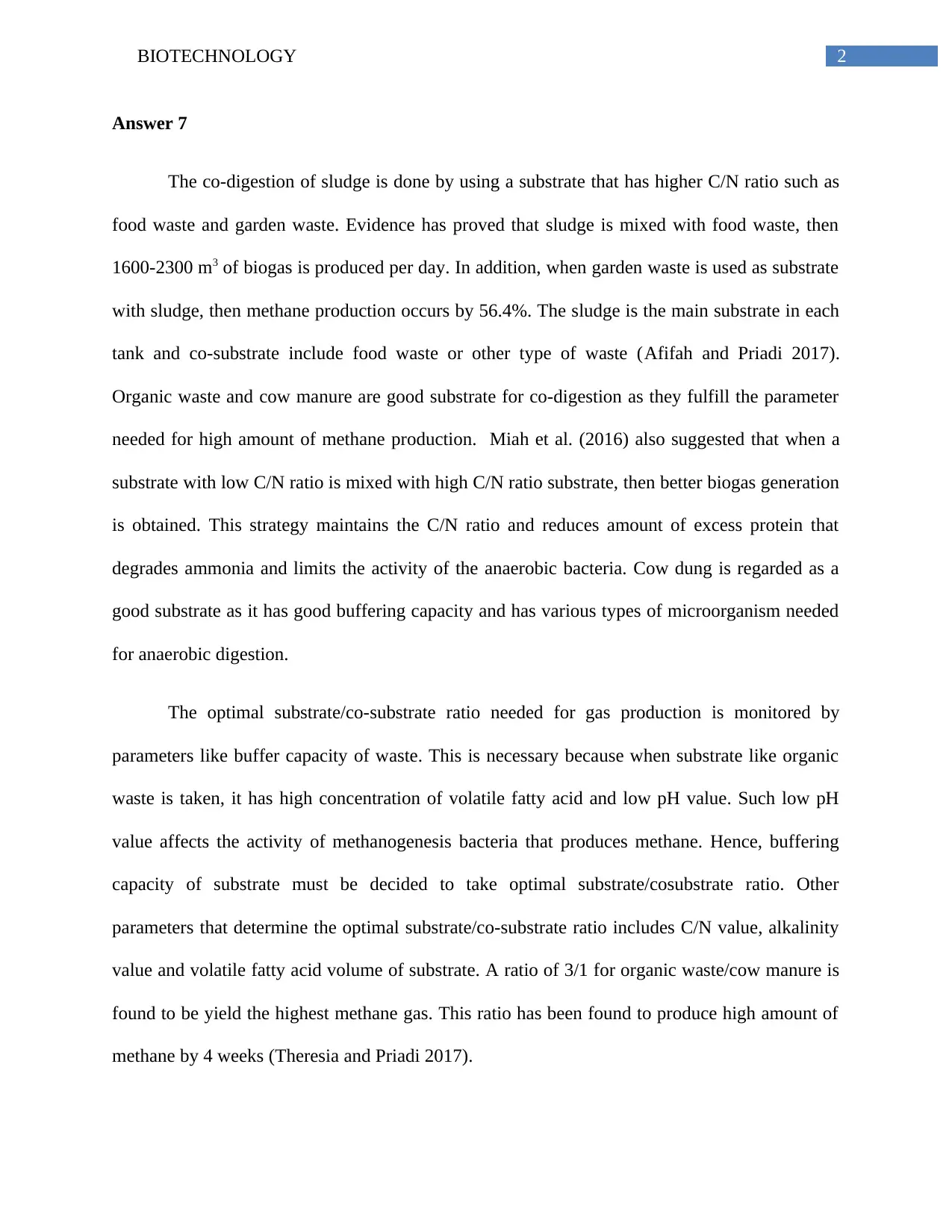
2BIOTECHNOLOGY
Answer 7
The co-digestion of sludge is done by using a substrate that has higher C/N ratio such as
food waste and garden waste. Evidence has proved that sludge is mixed with food waste, then
1600-2300 m3 of biogas is produced per day. In addition, when garden waste is used as substrate
with sludge, then methane production occurs by 56.4%. The sludge is the main substrate in each
tank and co-substrate include food waste or other type of waste (Afifah and Priadi 2017).
Organic waste and cow manure are good substrate for co-digestion as they fulfill the parameter
needed for high amount of methane production. Miah et al. (2016) also suggested that when a
substrate with low C/N ratio is mixed with high C/N ratio substrate, then better biogas generation
is obtained. This strategy maintains the C/N ratio and reduces amount of excess protein that
degrades ammonia and limits the activity of the anaerobic bacteria. Cow dung is regarded as a
good substrate as it has good buffering capacity and has various types of microorganism needed
for anaerobic digestion.
The optimal substrate/co-substrate ratio needed for gas production is monitored by
parameters like buffer capacity of waste. This is necessary because when substrate like organic
waste is taken, it has high concentration of volatile fatty acid and low pH value. Such low pH
value affects the activity of methanogenesis bacteria that produces methane. Hence, buffering
capacity of substrate must be decided to take optimal substrate/cosubstrate ratio. Other
parameters that determine the optimal substrate/co-substrate ratio includes C/N value, alkalinity
value and volatile fatty acid volume of substrate. A ratio of 3/1 for organic waste/cow manure is
found to be yield the highest methane gas. This ratio has been found to produce high amount of
methane by 4 weeks (Theresia and Priadi 2017).
Answer 7
The co-digestion of sludge is done by using a substrate that has higher C/N ratio such as
food waste and garden waste. Evidence has proved that sludge is mixed with food waste, then
1600-2300 m3 of biogas is produced per day. In addition, when garden waste is used as substrate
with sludge, then methane production occurs by 56.4%. The sludge is the main substrate in each
tank and co-substrate include food waste or other type of waste (Afifah and Priadi 2017).
Organic waste and cow manure are good substrate for co-digestion as they fulfill the parameter
needed for high amount of methane production. Miah et al. (2016) also suggested that when a
substrate with low C/N ratio is mixed with high C/N ratio substrate, then better biogas generation
is obtained. This strategy maintains the C/N ratio and reduces amount of excess protein that
degrades ammonia and limits the activity of the anaerobic bacteria. Cow dung is regarded as a
good substrate as it has good buffering capacity and has various types of microorganism needed
for anaerobic digestion.
The optimal substrate/co-substrate ratio needed for gas production is monitored by
parameters like buffer capacity of waste. This is necessary because when substrate like organic
waste is taken, it has high concentration of volatile fatty acid and low pH value. Such low pH
value affects the activity of methanogenesis bacteria that produces methane. Hence, buffering
capacity of substrate must be decided to take optimal substrate/cosubstrate ratio. Other
parameters that determine the optimal substrate/co-substrate ratio includes C/N value, alkalinity
value and volatile fatty acid volume of substrate. A ratio of 3/1 for organic waste/cow manure is
found to be yield the highest methane gas. This ratio has been found to produce high amount of
methane by 4 weeks (Theresia and Priadi 2017).
⊘ This is a preview!⊘
Do you want full access?
Subscribe today to unlock all pages.

Trusted by 1+ million students worldwide
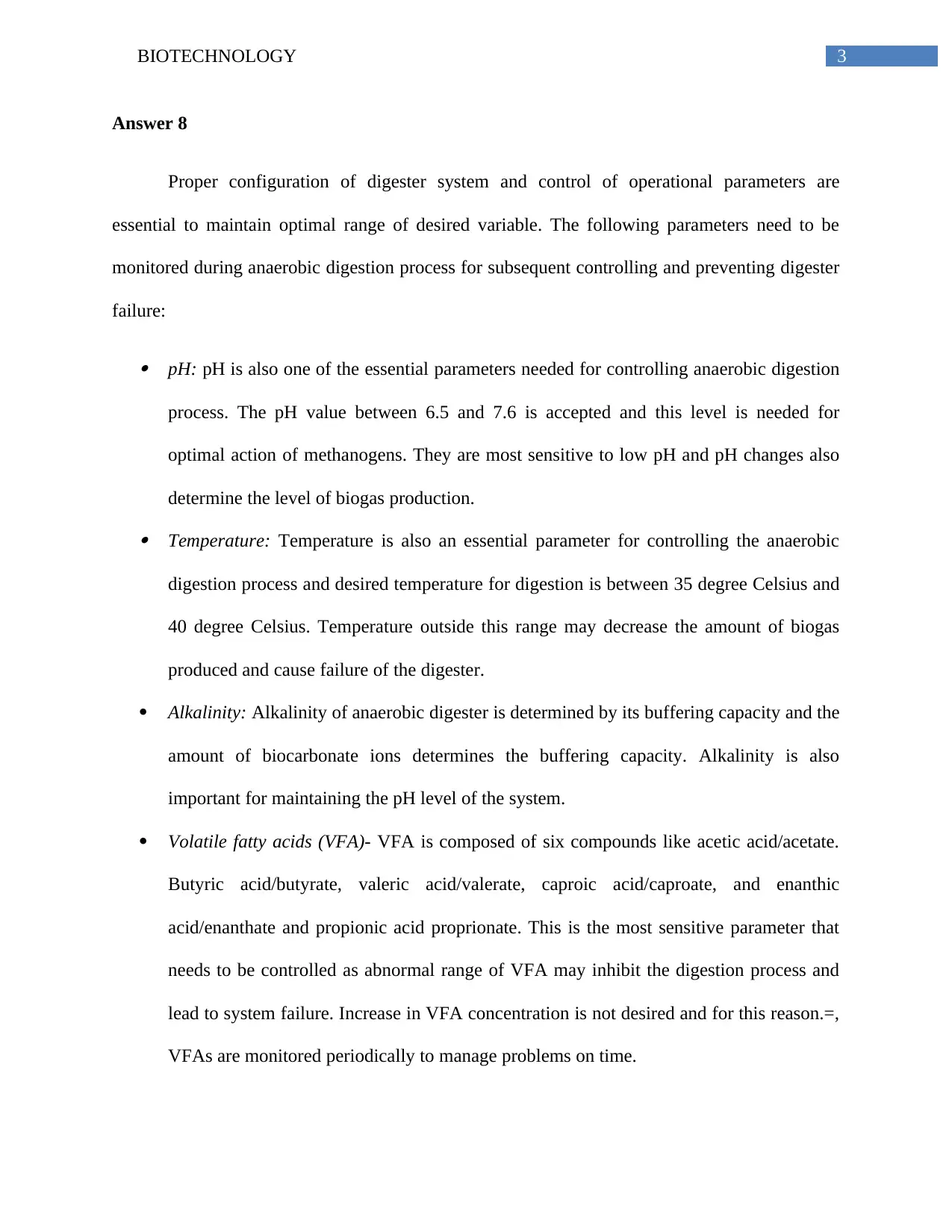
3BIOTECHNOLOGY
Answer 8
Proper configuration of digester system and control of operational parameters are
essential to maintain optimal range of desired variable. The following parameters need to be
monitored during anaerobic digestion process for subsequent controlling and preventing digester
failure:
pH: pH is also one of the essential parameters needed for controlling anaerobic digestion
process. The pH value between 6.5 and 7.6 is accepted and this level is needed for
optimal action of methanogens. They are most sensitive to low pH and pH changes also
determine the level of biogas production. Temperature: Temperature is also an essential parameter for controlling the anaerobic
digestion process and desired temperature for digestion is between 35 degree Celsius and
40 degree Celsius. Temperature outside this range may decrease the amount of biogas
produced and cause failure of the digester.
Alkalinity: Alkalinity of anaerobic digester is determined by its buffering capacity and the
amount of biocarbonate ions determines the buffering capacity. Alkalinity is also
important for maintaining the pH level of the system.
Volatile fatty acids (VFA)- VFA is composed of six compounds like acetic acid/acetate.
Butyric acid/butyrate, valeric acid/valerate, caproic acid/caproate, and enanthic
acid/enanthate and propionic acid proprionate. This is the most sensitive parameter that
needs to be controlled as abnormal range of VFA may inhibit the digestion process and
lead to system failure. Increase in VFA concentration is not desired and for this reason.=,
VFAs are monitored periodically to manage problems on time.
Answer 8
Proper configuration of digester system and control of operational parameters are
essential to maintain optimal range of desired variable. The following parameters need to be
monitored during anaerobic digestion process for subsequent controlling and preventing digester
failure:
pH: pH is also one of the essential parameters needed for controlling anaerobic digestion
process. The pH value between 6.5 and 7.6 is accepted and this level is needed for
optimal action of methanogens. They are most sensitive to low pH and pH changes also
determine the level of biogas production. Temperature: Temperature is also an essential parameter for controlling the anaerobic
digestion process and desired temperature for digestion is between 35 degree Celsius and
40 degree Celsius. Temperature outside this range may decrease the amount of biogas
produced and cause failure of the digester.
Alkalinity: Alkalinity of anaerobic digester is determined by its buffering capacity and the
amount of biocarbonate ions determines the buffering capacity. Alkalinity is also
important for maintaining the pH level of the system.
Volatile fatty acids (VFA)- VFA is composed of six compounds like acetic acid/acetate.
Butyric acid/butyrate, valeric acid/valerate, caproic acid/caproate, and enanthic
acid/enanthate and propionic acid proprionate. This is the most sensitive parameter that
needs to be controlled as abnormal range of VFA may inhibit the digestion process and
lead to system failure. Increase in VFA concentration is not desired and for this reason.=,
VFAs are monitored periodically to manage problems on time.
Paraphrase This Document
Need a fresh take? Get an instant paraphrase of this document with our AI Paraphraser
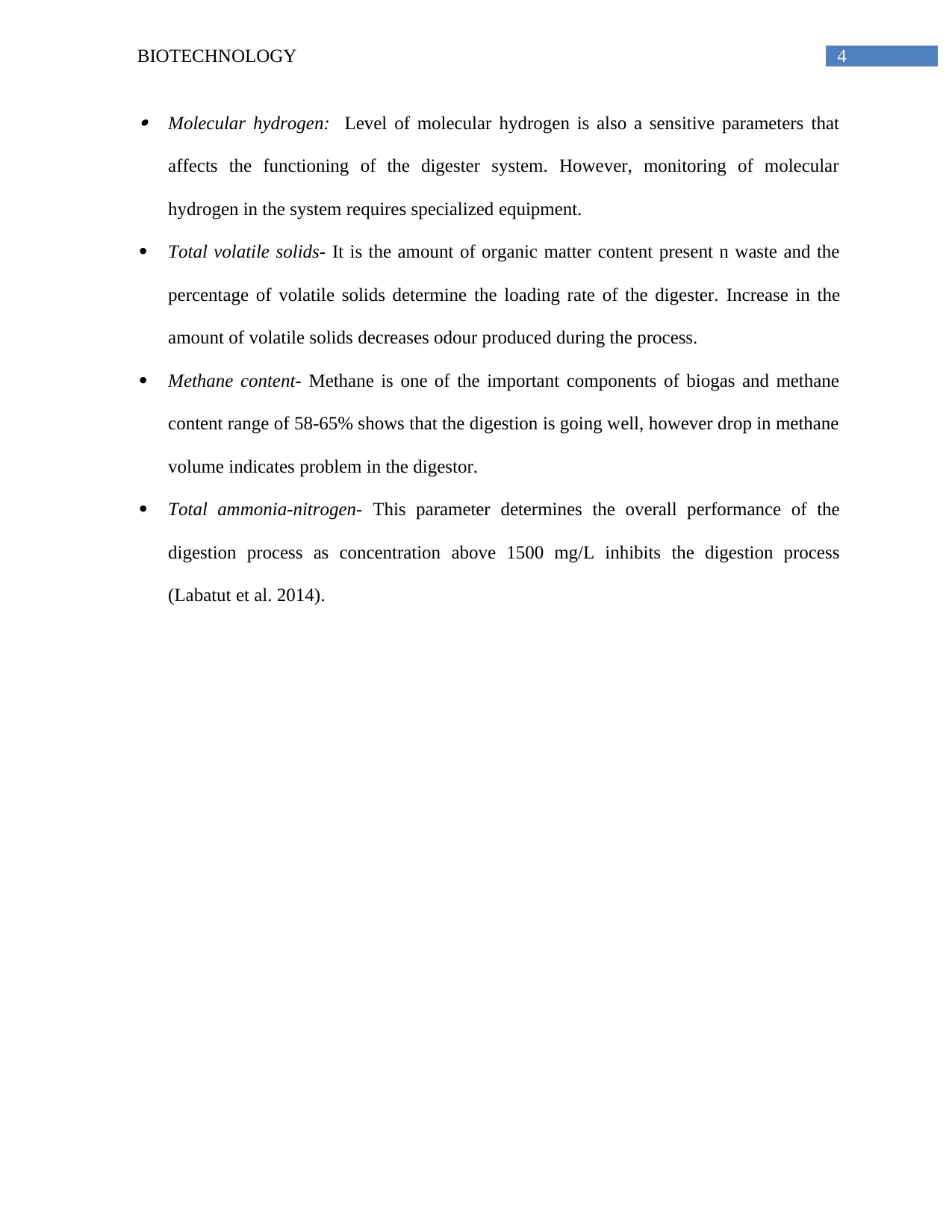
4BIOTECHNOLOGY
Molecular hydrogen: Level of molecular hydrogen is also a sensitive parameters that
affects the functioning of the digester system. However, monitoring of molecular
hydrogen in the system requires specialized equipment.
Total volatile solids- It is the amount of organic matter content present n waste and the
percentage of volatile solids determine the loading rate of the digester. Increase in the
amount of volatile solids decreases odour produced during the process.
Methane content- Methane is one of the important components of biogas and methane
content range of 58-65% shows that the digestion is going well, however drop in methane
volume indicates problem in the digestor.
Total ammonia-nitrogen- This parameter determines the overall performance of the
digestion process as concentration above 1500 mg/L inhibits the digestion process
(Labatut et al. 2014).
Molecular hydrogen: Level of molecular hydrogen is also a sensitive parameters that
affects the functioning of the digester system. However, monitoring of molecular
hydrogen in the system requires specialized equipment.
Total volatile solids- It is the amount of organic matter content present n waste and the
percentage of volatile solids determine the loading rate of the digester. Increase in the
amount of volatile solids decreases odour produced during the process.
Methane content- Methane is one of the important components of biogas and methane
content range of 58-65% shows that the digestion is going well, however drop in methane
volume indicates problem in the digestor.
Total ammonia-nitrogen- This parameter determines the overall performance of the
digestion process as concentration above 1500 mg/L inhibits the digestion process
(Labatut et al. 2014).
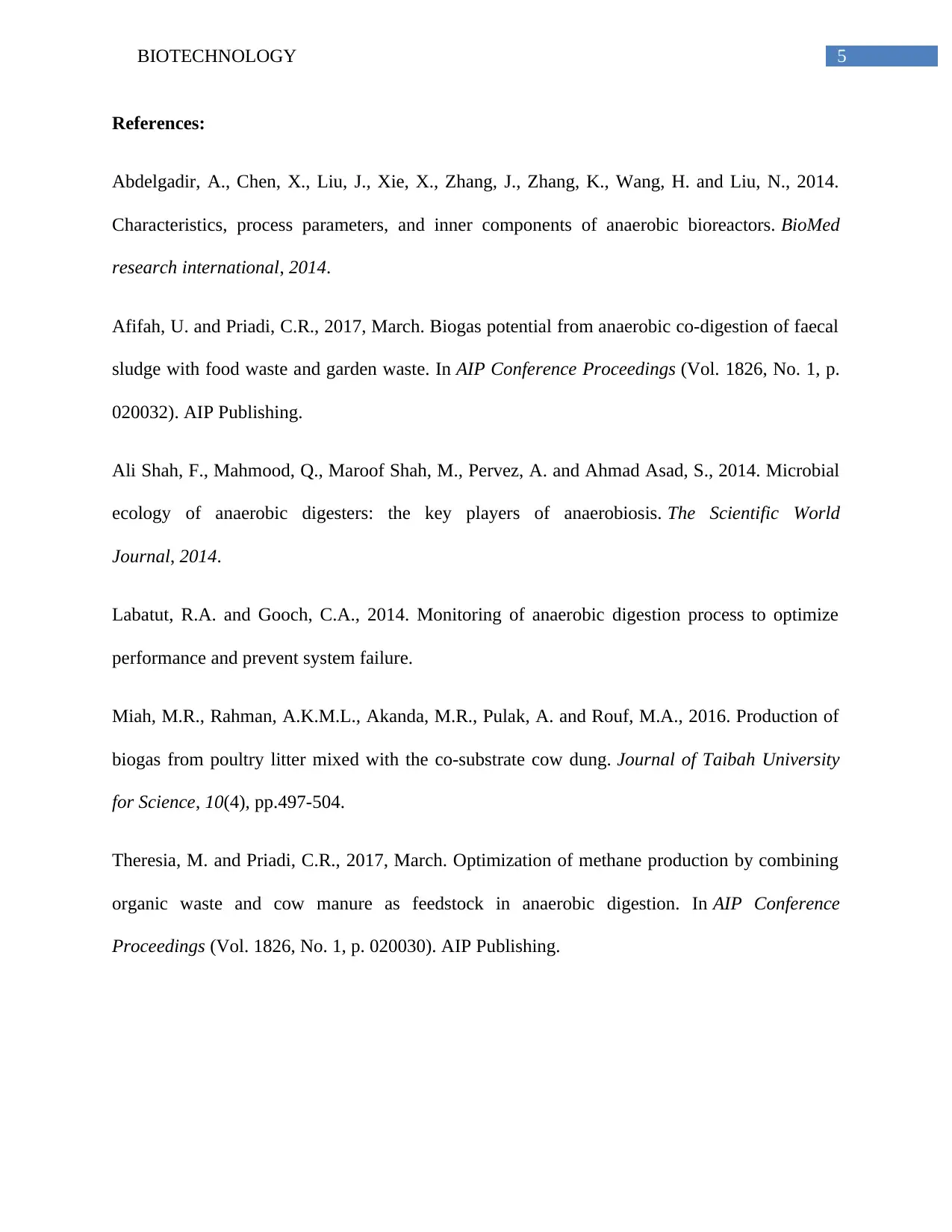
5BIOTECHNOLOGY
References:
Abdelgadir, A., Chen, X., Liu, J., Xie, X., Zhang, J., Zhang, K., Wang, H. and Liu, N., 2014.
Characteristics, process parameters, and inner components of anaerobic bioreactors. BioMed
research international, 2014.
Afifah, U. and Priadi, C.R., 2017, March. Biogas potential from anaerobic co-digestion of faecal
sludge with food waste and garden waste. In AIP Conference Proceedings (Vol. 1826, No. 1, p.
020032). AIP Publishing.
Ali Shah, F., Mahmood, Q., Maroof Shah, M., Pervez, A. and Ahmad Asad, S., 2014. Microbial
ecology of anaerobic digesters: the key players of anaerobiosis. The Scientific World
Journal, 2014.
Labatut, R.A. and Gooch, C.A., 2014. Monitoring of anaerobic digestion process to optimize
performance and prevent system failure.
Miah, M.R., Rahman, A.K.M.L., Akanda, M.R., Pulak, A. and Rouf, M.A., 2016. Production of
biogas from poultry litter mixed with the co-substrate cow dung. Journal of Taibah University
for Science, 10(4), pp.497-504.
Theresia, M. and Priadi, C.R., 2017, March. Optimization of methane production by combining
organic waste and cow manure as feedstock in anaerobic digestion. In AIP Conference
Proceedings (Vol. 1826, No. 1, p. 020030). AIP Publishing.
References:
Abdelgadir, A., Chen, X., Liu, J., Xie, X., Zhang, J., Zhang, K., Wang, H. and Liu, N., 2014.
Characteristics, process parameters, and inner components of anaerobic bioreactors. BioMed
research international, 2014.
Afifah, U. and Priadi, C.R., 2017, March. Biogas potential from anaerobic co-digestion of faecal
sludge with food waste and garden waste. In AIP Conference Proceedings (Vol. 1826, No. 1, p.
020032). AIP Publishing.
Ali Shah, F., Mahmood, Q., Maroof Shah, M., Pervez, A. and Ahmad Asad, S., 2014. Microbial
ecology of anaerobic digesters: the key players of anaerobiosis. The Scientific World
Journal, 2014.
Labatut, R.A. and Gooch, C.A., 2014. Monitoring of anaerobic digestion process to optimize
performance and prevent system failure.
Miah, M.R., Rahman, A.K.M.L., Akanda, M.R., Pulak, A. and Rouf, M.A., 2016. Production of
biogas from poultry litter mixed with the co-substrate cow dung. Journal of Taibah University
for Science, 10(4), pp.497-504.
Theresia, M. and Priadi, C.R., 2017, March. Optimization of methane production by combining
organic waste and cow manure as feedstock in anaerobic digestion. In AIP Conference
Proceedings (Vol. 1826, No. 1, p. 020030). AIP Publishing.
⊘ This is a preview!⊘
Do you want full access?
Subscribe today to unlock all pages.

Trusted by 1+ million students worldwide

6BIOTECHNOLOGY
1 out of 7
Your All-in-One AI-Powered Toolkit for Academic Success.
+13062052269
info@desklib.com
Available 24*7 on WhatsApp / Email
![[object Object]](/_next/static/media/star-bottom.7253800d.svg)
Unlock your academic potential
Copyright © 2020–2025 A2Z Services. All Rights Reserved. Developed and managed by ZUCOL.

